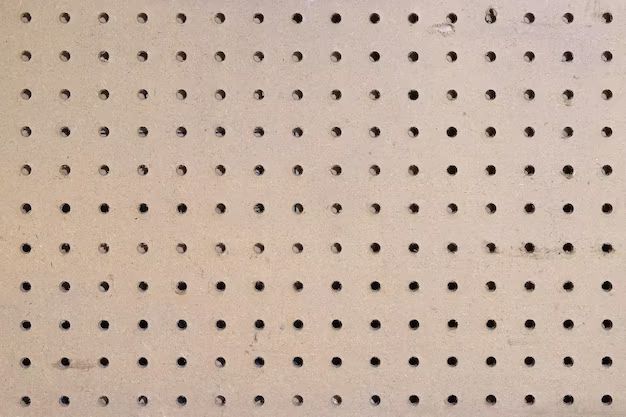Pegboard, also known as perforated hardboard, is a material that is commonly used for organization and storage purposes. It consists of a sheet made of compressed wood fibers with evenly spaced holes that allow pegs and hooks to be inserted. Pegboard offers a versatile system for hanging tools, supplies, and other items in workshops, garages, utility rooms, and more. But when it comes to pegboard, one question often arises: Is there a standard size for pegboard sheets and holes?
Page Contents
Standard Pegboard Sizes
The short answer is yes, there is a standard size for pegboard. The most common and widely used pegboard size is:
- 4 feet x 8 feet – This is the standard pegboard sheet size.
- 1/4 inch diameter holes – This is the standard hole size.
- 1 inch spacing between hole centers – The holes are spaced 1 inch apart (measured center to center).
4 feet x 8 feet pegboard sheets with 1/4 inch holes spaced 1 inch apart are mass produced and readily available at most hardware stores and home improvement retailers. This size has become the industry standard over the years, allowing pegboard accessories like hooks, baskets, and shelves to be designed to fit the holes.
Other Common Pegboard Sizes
While 4 x 8 feet with 1/4 inch holes is considered the standard, it is not the only size pegboard comes in. Some other commonly available sizes include:
- 2 feet x 4 feet
- 3 feet x 5 feet
- 4 feet x 4 feet
- 1 foot x 8 feet panels
The hole diameter and spacing remains the same at 1/4 inch and 1 inch respectively. The smaller sizes are useful for organizing smaller areas like lockers, shelves, cabinets and workstations.
Metric Pegboard Sizes
In some countries that utilize the metric system, pegboard sizes are based on metric dimensions:
- 1200 mm x 2400 mm – Approximately equivalent to 4 feet x 8 feet
- 600 mm x 1200 mm – Approximately equivalent to 2 feet x 4 feet
- 900 mm x 1500 mm – Approximately equivalent to 3 feet x 5 feet
The distance between hole centers is 25 mm rather than 1 inch (25.4 mm). But the hole diameter remains very close at 6 mm vs. 1/4 inch (6.35 mm). So accessories designed for standard 1/4″ pegboard will generally still work on metric 6 mm pegboard, though the fit may be slightly loose.
Common Thicknesses
In addition to sizes, pegboard is also available in different thicknesses. The most common thicknesses are:
- 1/8 inch – Thinner and more lightweight
- 1/4 inch – Standard thickness, provides durability
- 3/8 inch – Extra thick and heavy duty
- 1/2 inch – Thickest option for holding very heavy items
1/4 inch and 3/8 inch are considered standard thicknesses for general purpose use. 1/8 inch may not be as durable but is easy to cut and mount. 1/2 inch is reserved for industrial strength applications.
Pegboard Hole Options
In addition to the standard 1/4″ round holes, pegboard is also available with different hole shapes and arrangements:
- Square holes – Allows for hooks with multiple orientations.
- Slotted holes – Enables side-to-side adjustability.
- Hexagonal holes – Offers greater holding power and grip.
- Combination patterns – Mixes round, square, and slotted holes.
These alternate hole options provide greater flexibility and versatility. But the standard round 1/4″ hole pegboard remains the most common style.
Pegboard Brands
Some of the major manufacturers and brands that produce pegboard in the standard 4×8 foot size with 1/4″ holes include:
- Gladiator
- Wall Control
- Rubbermaid
- Stanley
- Workrite
- Monroe
Each brand may offer slight variations in hole pattern, thickness, surface texture, and quality. But they adhere to the common 1/4″ hole size and 1″ spacing standard.
Advantages of Standardized Sizing
Having a widely used standard size for pegboard offers several advantages:
- Interchangeability – Standardized sizing means pieces from different brands or manufacturers will fit together properly.
- Compatibility – Accessories like hooks, baskets, shelves etc. are designed to work with the standard hole spacing.
- Consistency – Workers who use pegboard in multiple locations don’t have to adjust to different hole patterns.
- Convenience – Standard sheets are easy to find at retail stores or order online.
- Cost Savings – Economies of scale in manufacturing helps lower costs of standard size pegboard.
The established standard sizes have allowed pegboard to become a widely used organizational tool with broad compatibility and convenience.
Cutting Pegboard to Custom Sizes
While the 4×8 size pegboard is standard, you can also cut sheets to create customized sizes:
- Use a table saw, circular saw, or jigsaw with fine tooth blade to cut clean lines.
- Cut pegboard face up to avoid tear out on the finished side.
- Support the sheet near the cut line to prevent vibration.
- Cut pieces oversized, then trim to final size for accuracy.
- Use a router or file to smooth cut edges.
With care pegboard can be cut to any needed width or length. Some tips for custom sizing:
- Map out hole spacing to optimize cut lines.
- Avoid leaving small fragments of board with few holes.
- Cut hole columns rather than across holes for clean openings.
- Plan additional structural supports for large sheets.
Proper planning allows pegboard to be customized while maintaining maximum usefulness of the holes.
Conclusion
Pegboard is available in a range of sizes, thicknesses, hole shapes and brands. But the 4 foot x 8 foot size with 1/4 inch holes spaced 1 inch apart has emerged as the dominant industry standard. This consistency offers interchangeability, compatibility, and convenience for both manufacturers and end users. But pegboard remains versatile and can be cut to smaller custom sizes as needed. Following the standard dimensions allows pegboard to be a flexible organizational tool for many situations.
